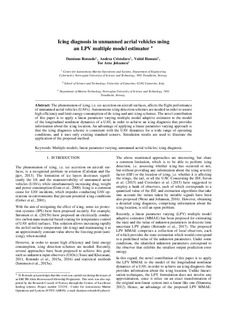| dc.contributor.author | Rotondo, Damiano | |
| dc.contributor.author | Cristofaro, Andrea | |
| dc.contributor.author | Hassani, Vahid | |
| dc.contributor.author | Johansen, Tor Arne | |
| dc.date.accessioned | 2017-12-13T09:00:50Z | |
| dc.date.available | 2017-12-13T09:00:50Z | |
| dc.date.created | 2017-11-20T14:12:40Z | |
| dc.date.issued | 2017 | |
| dc.identifier.citation | IFAC-PapersOnLine. 2017, 50 (1), 5238-5243. | nb_NO |
| dc.identifier.issn | 2405-8963 | |
| dc.identifier.uri | http://hdl.handle.net/11250/2470965 | |
| dc.description.abstract | The phenomenon of icing, i.e. ice accretion on aircraft surfaces, affects the flight performance of unmanned aerial vehicles (UAVs). Autonomous icing detection schemes are needed in order to assure high efficiency and limit energy consumption of de-icing and anti-icing schemes. The novel contribution of this paper is to apply a linear parameter varying multiple model adaptive estimator to the model of the longitudinal nonlinear dynamics of a UAV, in order to achieve an icing diagnosis that provides information about the icing location. An advantage of applying a linear parameter varying approach is that the icing diagnosis scheme is consistent with the UAV dynamics for a wide range of operating conditions, and it uses only existing standard sensors. Simulation results are used to illustrate the application of the proposed method. | nb_NO |
| dc.language.iso | eng | nb_NO |
| dc.publisher | Elsevier | nb_NO |
| dc.rights | Attribution-NonCommercial-NoDerivatives 4.0 Internasjonal | * |
| dc.rights.uri | http://creativecommons.org/licenses/by-nc-nd/4.0/deed.no | * |
| dc.title | Icing diagnosis in unmanned aerial vehicles using an LPV multiple model estimator | nb_NO |
| dc.type | Journal article | nb_NO |
| dc.type | Peer reviewed | nb_NO |
| dc.description.version | acceptedVersion | nb_NO |
| dc.source.pagenumber | 5238-5243 | nb_NO |
| dc.source.volume | 50 | nb_NO |
| dc.source.journal | IFAC-PapersOnLine | nb_NO |
| dc.source.issue | 1 | nb_NO |
| dc.identifier.doi | 10.1016/j.ifacol.2017.08.462 | |
| dc.identifier.cristin | 1516133 | |
| dc.relation.project | Norges forskningsråd: 223254 | nb_NO |
| dc.description.localcode | © 2017, IFAC (International Federation of Automatic Control) Hosting by Elsevier Ltd. All rights reserved. This is the authors’ accepted and refereed manuscript to the article. | nb_NO |
| cristin.unitcode | 194,63,25,0 | |
| cristin.unitcode | 194,64,20,0 | |
| cristin.unitname | Institutt for teknisk kybernetikk | |
| cristin.unitname | Institutt for marin teknikk | |
| cristin.ispublished | true | |
| cristin.fulltext | postprint | |
| cristin.qualitycode | 1 | |

